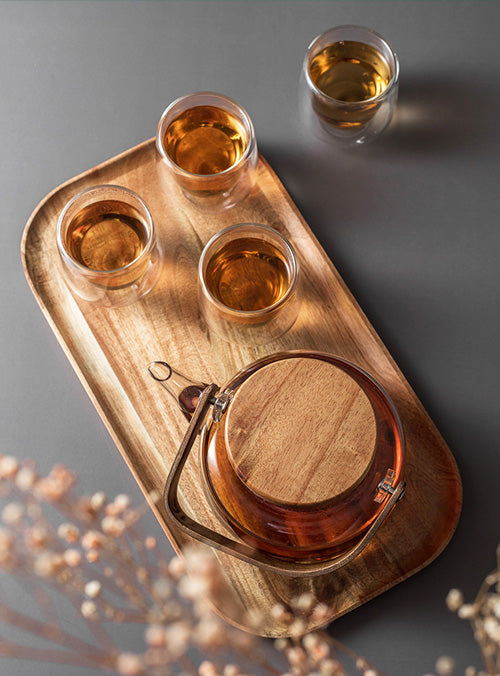How to Choose Teapot
Posted by SALINA - TEAS.COM.AU

Here is a guide to the pros and cons of glass, cast iron, ceramic, clay and other teapots, as well as design and functionality.
To answer this question, there are 4 basic points to consider:
1. Design (look and feel)
2. Design (functionality)
3. Intended usage
4. Materials
- Design (look and feel): The selection of a teapot is as individualistic as the person choosing it. Like the saying of “love at first sight”, you should choose a teapot you will like and feel comfortable with (or the intended user). Imagine yourself making tea with it, is it comfortable to hold? Do you like the colour or design? Does it speak to you?
- Design (functionality): A well made teapot should be have the handle, opening (where you put the leaves and water in) and the beak aligned in one straight line. Some like a metal basket inside the teapot to hold the leaves tidily but we tend to shy away from this design as the metal can taint the taste of the tea. Because most teapots are bought to be used, verses collectibles, it is important to think about the intended usage.
- Intended usage: Many of our customers ask why choose small teapots. The reason is better tea making practice.
A smaller teapot encourages you to drain all the tea out of the teapot, into your cup(s), once the tea is made. This way you won’t have over-steeped your tea left in the teapot.
Once the first infusion is completely drained, add fresh boiling water to make the second infusion and so on. We believe nowadays most of us don’t live in a household of more than 5 people. So why having a “typical” size teapot, making more tea than you need?
Enjoy your tea, don’t make it so you can waste it (or force your partner or children to drink it with you)
Having said that, if you intend to use the teapot to serve a lot of people most of the time, then a “grandma” size teapot will make life a lot easier. - Materials: Teapots have been around for centuries and for different cultures. There are teapots made with different materials.
The following paragraphs explore some of the most common materials, but there are others such as jade, agate, crystal, silver, stainless steel and glazed iron. We advise strongly to avoid teapots made from pewter, aluminum, uncoated iron, plastic, lacquered bamboo or other synthetics. These materials oxidize easily and can (even if not harmful) greatly affect the taste of the tea.
Glass
Many people love glass teapots because they consider the visual transformation of the dry leaves opening up to regain its original leafy shape an integral part of the tea drinking. To keep the glass teapot from tea stains, soak it regularly in diluted detergent water. Rise in hot water and air dry. Glass is by far our most recommended choice of teapot material as it makes a neutral cup without tainting the true colour and taste of the tea, while showing the colour and transformation of the tea leaves. Tea is meant to be enjoyed once it is made, so although one may argue glass doesn’t retain heat well, it is actually a good thing because that forces you to have a micro-break and enjoy your cuppa while it is still hot!
Porcelain
For many, porcelain is the traditional material to make a teapot. It maintains a good infusion temperature while being relatively carefree. As most porcelain teaware are fairly delicate, we recommend against dishwashing.
Clay
Because of its porous nature, clay can enhance the texture, aroma and taste of the infusion. However, also because of its porous character, clay teapot will take up the aroma of the tea it is used for. For this reason, many people have a different clay teapot for different teas. Many Chinese tea drinking purists will tell you they have a pot for Formosa Oolong, another one for Pu-erh, another one for Keemun and so on.
Yixing (also called Zisha) teapot is probably the most highly regarded in the world of clay teapots. The best grade of Yixing teapots are very strong (a person can stand on it and it won't break!) and can improve the quality of the infusion. Go to a reliable merchant as there are a lot of imitations on Yixing teapots.
Tetsubin (Iron pots, coated)
Cast iron teapots were originated from China and the Japanese further developed them into this amazing decorative yet practical craft.
The cast iron teapot was originally used as a kettle in Japan but during the mid-19th century as tea drinking became popular, tetsubin became a status symbol. Tetsubin designs have become more decorative from that point on.
Tetsubin, like other cast iron cooking utensils, spreads heat evenly and keeps it well. It adds iron to your diet. Caring for Tetsubin is quite simple – rinse right after each use and wipe dry. Do not use Tetsubin on a stove!
Modern tetsubin typically has an enamel coating inside the teapot for hygiene reason. Also known for durability and heat retention, the cast iron teapot will last for a lifetime or two!

AUSTRALIA'S FINEST LOOSE LEAF TEAS
Explore Australia's largest selection of Premium Teas & All-Natural Organic Herbal Blends.






